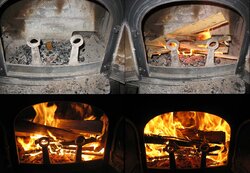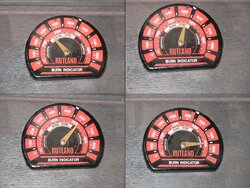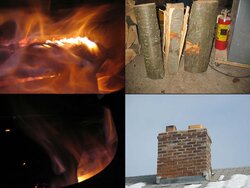(Curious) George said:
The red line on the chart is for the dry-basis moisture content, which is what moisture meters read, and currently stands at about 29%.
George, no offense, but for a guy who doesn't even have a stove yet, you seem pretty sure about how dry wood needs to be to burn well.
I started a fire with 100% BattenKilner rocket fuel exactly one week after I first brought it into the basement. I set things up so that I would get the fastest possible startup I could achieve. Well, things went so fast I didn't even have time to write much down. Thankfully, I was able to get a timeline by looking at the EXIF data from the few shots I was able to take of the process:
I went down to check the stove just before 10 AM. Top was at 125º, flue was about 75º (room temp). I thoroughly cleaned out the ashes and pushed together the small pile of coals that was left from the night before. In a departure from my usual starting practice, I decided to use a small wax/sawdust firestarter of my own making. They are about 1" square - maybe 1/10 the volume of a Super Cedar (a type commonly used by Hearth members).
First photo is time stamped at 9:52:09, just prior to lighting the starter.
Second shot was taken at 9:55:44, 3 minutes and 33 seconds later. I added more wood at this point and closed the doors.
Third shot was at 9:57:05, 1 minute and 21 seconds after the wood addition. Closed the doors again.
Fourth shot was at 9:58:41, 1 minute and 36 seconds later. I closed the doors, shut the intake damper to about 1/4 open, and waited while the temps rose.
Here are the stove top temps as they climbed:
10:00:38 - 350ºF - 8 minutes and 27 seconds after lighting
10:03:17 - 525ºF - 11 minutes and 8 seconds after lighting
10:05:40 - 600ºF - 13 minutes and 23 seconds after lighting
10:09:00 - 700ºF - 16 minutes and 51 seconds after lighting
About that time I started to smell that old familiar smell... screaming hot flue pipe. My magnetic flue thermometer is pretty accurate, but it has a very long lag time. It only said 525º, but I grabbed my IR gun and shot the pipe. 785ºF! I quickly opened the top loading door to kill the draft a bit and help cool it off. It dropped to about 715ºF, and I decided to toss in the main load. Three splits of progressively larger size, loaded quickly, one after the other:
7 lbs/3 oz, 9 lbs/7 oz, and 14 lbs/4 oz, for a total load of 29 lbs/14oz.
The large splits ignited immediately upon hitting the wood below (see flames shooting around wood on the right), and I closed the load door. I waited until the flue temps got up (about 600ºF flue, 750ºF stove top) and closed the bypass about 29 minutes after I struck the match. At 10:32:52 I snapped the shot of the smoking (?) chimney seen in the lower right hand corner of the last sequence - exactly 40 minutes and 41 seconds after liftoff. Went back inside and the stove was cruising at 700ºF, flue temp stable at 375ºF. At no time after the first few minutes was the intake damper open more than about 1/4 of the way, and I only opened the stove doors for a second or so to take the photos (no glass on my stove), so there was no huge air boost needed to get the wood to take off.
This all happened during the time that most EPA stoves would have been functioning without secondary combustion yet occurring, operating strictly in an updraft, cold-start mode. Therefore, I see no compelling evidence why it wouldn't go identically in a good EPA stove with decent draft, especially the first 30 minutes of the burn.
EDIT: The last photo in the stove top thermometer sequence is not the correct one. That was taken a few minutes after the main load was loaded. The actual time-stamped photo taken at 10:09:00 was showing 700ºF as I stated in the text.





